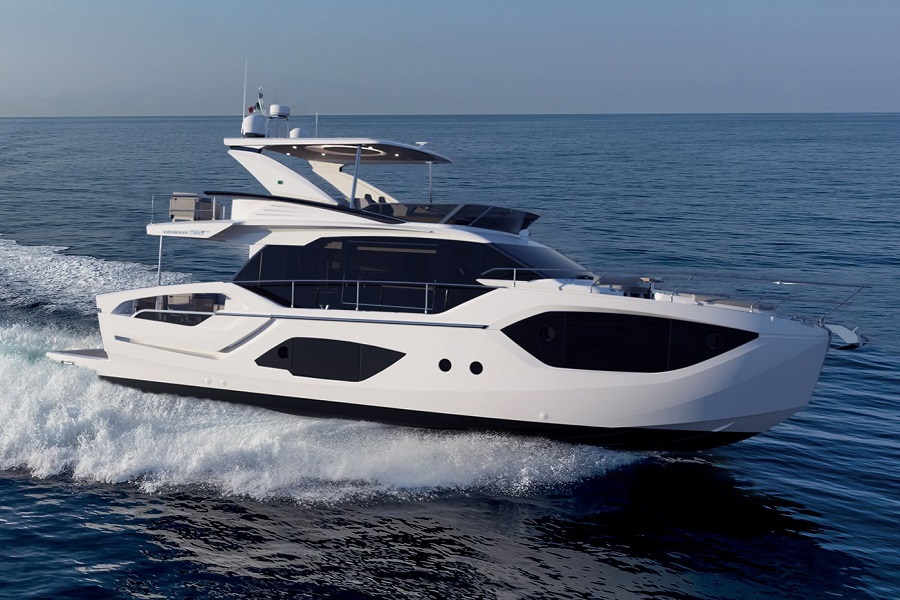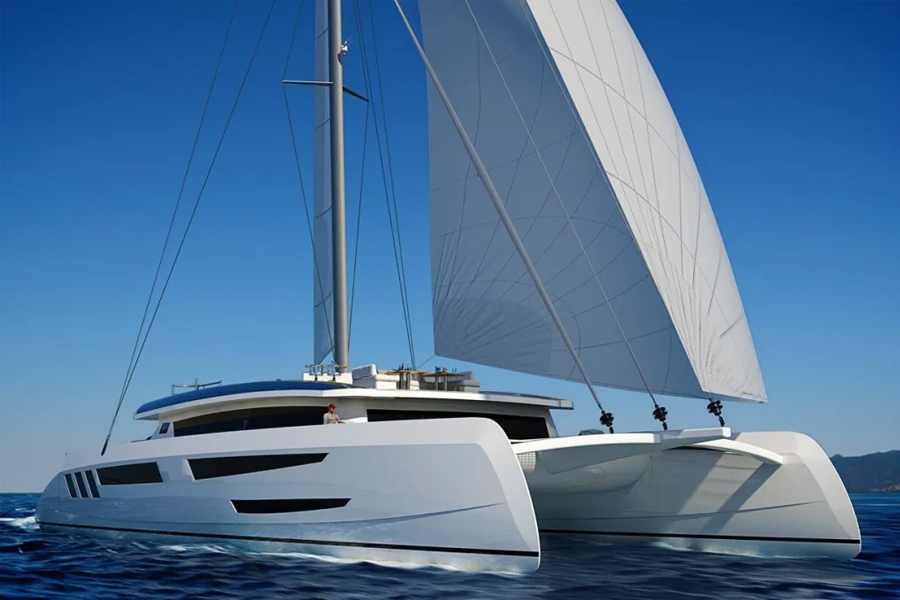 alt="Absolute signatures feature on 52 Fly"/>
alt="Absolute signatures feature on 52 Fly"/>
 alt="Marc Pajot designs boomless ‘Eco Yacht’"/>
alt="Marc Pajot designs boomless ‘Eco Yacht’"/>
Pajot Custom Yachts has released a spectacular concept for ‘The Eco Yacht’ Catamaran 110’, an innovative easy-sailing cat without a boom. Features include forward helm stations integrated into the side decks, supported by an interior navigation and monitoring station.
The boomless yacht – a design as old as the first Dart 16 and more recently used on the AC75 yachts for the 36th America’s Cup – incorporates a narrow, square-topped mainsail (180sqm), which can be hoisted or lowered in less than four minutes and stored in a locker on the expansive flybridge.

Marc Pajot’s ‘Eco Yacht’ concept is a 110ft catamaran without a boom
“The absence of a boom allows for very simple, safe trimming,” says company founder Marc Pajot, the legendary French sailor who has been designing racing multihulls since 1980 and involved in the brokerage of luxury yachts since 2001.
Pajot, 67, created the 110-footer with Nicolas Fauroux, an engineer and naval architect whose designs include the 40m sloop Vaimiti, as well as Franck de Rivoyre and Christophe Larose, structural and rigging engineers who have worked on the majority of sailing catamarans over 18m (59ft) including round-the-world record breakers Foncia and Groupama.

The narrow, square-topped mainsail can be hoisted or lowered in less than four minutes
The Catamaran 110’ has aluminium hulls and bridge deck, composite coachroof and flybridge superstructures, and a carbon rig, which includes a 110sqm jib, a 264sqm genoa and a gennaker up to 790sqm, all mounted on electric furlers. The mast is set slightly aft of centre.
Trimming and manoeuvres are carried out on captive winches with electric controls, with automated deck hardware allowing fingertip manoeuvres from the helm stations or anywhere on board using the remote control.

Solar energy can be stored for autonomy at anchor
Power-saving and emission-reducing features include diesel-electric propulsion, service power supplied by 70sqm of solar panels and hydrodynamic generators, and electric energy storage for autonomy at anchor.
The engine rooms with generators and battery banks are in the centre of the hull, which features 1.6m of bridgedeck clearance.

The yacht features a wide array of outdoor living areas
“There’s no more need for heavy, complicated, fuel-consuming and noisy yachts,” says Pajot, whose sailing resume includes a 1972 Olympic silver medal in Flying Dutchman with his brother Yves, victory in the 1982 Route du Rhum and two America’s Cup semi-finals.
“This is the birth of a real ‘E’ yacht featuring catamaran hulls with a low hydrodynamic drag, a simple and efficient sail system, and a large source of solar and hydraulic energy associated with hybrid electric propulsion, which all bring technology to the service of ecology.”

The beach club has a pool, drop-down sides and sugar-scoop swim platforms and is overlooked by two aft VIP cabins
The yacht’s spectacular social areas include 200sqm (2,150sqft) of outdoor space including a beach club with a pool, drop-down sides and large sugar-scoop swim platforms.
The vast flybridge can be shaded by biminis and features multiple sofas, loungers and a bar, while the foredeck has sunken lounging areas either side of a jacuzzi.

The vast flybridge can be shaded by biminis and features multiple sofas, loungers and a bar
The interior space also covers more than 200sqm and includes a large saloon to starboard and a dining table and bar to port.
Forward to port is a huge, enclosed galley, while starboard is a 22sqm master cabin with a forward-facing bed and private exterior access.

The foredeck has lounging areas either side of a jacuzzi, and offers access to the side helm stations
Aft steps on both sides lead to spectacular VIP cabins that each look out on to the beach club and sea. The interior décor, furniture and fittings can be customised for the owner.